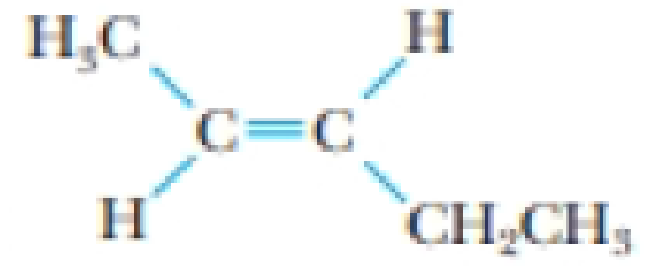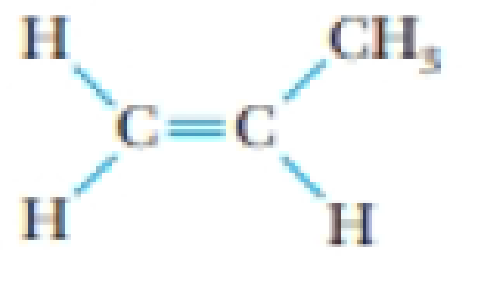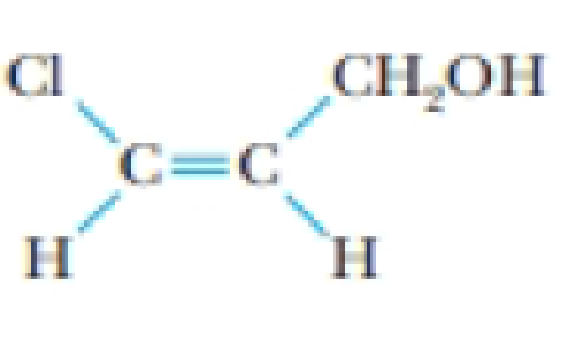
Chemistry and Chemical Reactivity - AP Edition
10th Edition
ISBN: 9781337399203
Author: Kotz
Publisher: CENGAGE L
expand_more
expand_more
format_list_bulleted
Concept explainers
Textbook Question
Chapter 9, Problem 18PS
For each compound below, decide whether cis and trans isomers are possible. If isomerism is possible, draw the other isomer.



Expert Solution & Answer
Trending nowThis is a popular solution!

Students have asked these similar questions
Please do these questions within the SCH4U course please with full steps since I am still unsure how to format my answers! Thank you so much.
When two solutions, one of 0.1 M KCl (I) and the other of 0.1 M MCl (II), are brought into contact by a membrane. The cation M cannot cross the membrane. At equilibrium, x moles of K+ will have passed from solution (I) to (II). To maintain the neutrality of the two solutions, x moles of Cl- will also have to pass from I to II. Explain this equality: (0.1 - x)/x = (0.1 + x)/(0.1 - x)
Calculate the variation in the potential of the Pt/MnO4-, Mn2+ pair with pH, indicating the value of the standard potential. Data: E0 = 1.12.
Chapter 9 Solutions
Chemistry and Chemical Reactivity - AP Edition
Ch. 9.1 - Use valence bond theory to describe the bonding in...Ch. 9.1 - Identify the hybridization of each underlined atom...Ch. 9.1 - Use valence bond theory to describe the bonding in...Ch. 9.2 - What is the electron configuration of the H2+ ion?...Ch. 9.2 - Could the anion Li2 exist? What is the ions bond...Ch. 9.2 - The cations O2+ and N2+ are formed when molecules...Ch. 9.3 - Photoelectron spectroscopy is s1milar to the...Ch. 9.3 - What is the energy of a photon with a wavelength...Ch. 9.3 - Using the accompanying figure, state which...Ch. 9.3 - The kinetic energy of an electron ejected from the...
Ch. 9.3 - The N2+ ions that are formed when electrons with...Ch. 9.3 - What is the empirical formula of Tynan purple?Ch. 9.3 - Butter yellow absorbs light with a wavelength of...Ch. 9.3 - Prob. 2.3ACPCh. 9 - Draw the Lewis structure for chloroform, CHCl3....Ch. 9 - Draw the Lewis structure for NF3. What are its...Ch. 9 - Draw the Lewis structure for hydroxylamine, H2NOH....Ch. 9 - Draw the Lewis structure for 1,...Ch. 9 - Draw the Lewis structure for carbonyl fluoride,...Ch. 9 - Draw the Lewis structure for acetamide, CH3CONH2....Ch. 9 - Specify the electron-pair and molecular geometry...Ch. 9 - Specify the electron-pair and molecular geometry...Ch. 9 - Prob. 9PSCh. 9 - What is the hybrid orbital set used by each of the...Ch. 9 - Draw the Lewis structures of the acid HPO2F2 and...Ch. 9 - Draw the Lewis structures of the arid HSO3F and...Ch. 9 - What is the hybridization of the carbon atom in...Ch. 9 - What is the hybridization of the carbon atoms in...Ch. 9 - What is the electron-pair and molecular geometry...Ch. 9 - What is the electron-pair and molecular geometry...Ch. 9 - Prob. 17PSCh. 9 - For each compound below, decide whether cis and...Ch. 9 - Molecular Orbital Theory (See Examples 9.49.6.)...Ch. 9 - Give the electron configurations for the ions Li2+...Ch. 9 - Calcium carbide, CaC2, contains the acetylide ion,...Ch. 9 - Platinum hexafluoride is an extremely strong...Ch. 9 - When sodium and oxygen react, one of the products...Ch. 9 - When potassium and oxygen react, one of the...Ch. 9 - Among the following, which has the shortest bond...Ch. 9 - Consider the following list of small molecules and...Ch. 9 - Prob. 27PSCh. 9 - The nitrosyl ion. NO+, has an interesting...Ch. 9 - These questions are not designated as to type or...Ch. 9 - What is the OSO angle and the hybrid orbital set...Ch. 9 - Sketch the resonance structures for the nitrite...Ch. 9 - Sketch the resonance structures for the nitrate...Ch. 9 - Sketch the resonance structures for the N2O...Ch. 9 - Compare the structure and bonding in CO2 and CO32...Ch. 9 - Numerous molecules are detected in deep space....Ch. 9 - Acrolein, a component of photochemical smog, has a...Ch. 9 - The organic compound below is a member of a class...Ch. 9 - The compound sketched below is acetylsalicylic...Ch. 9 - Phosphoserine is a less-common amino acid. (a)...Ch. 9 - Lactic acid is a natural compound found in sour...Ch. 9 - Cinnamaldehyde ocaus naturally in cinnamon oil....Ch. 9 - The ion Si2 was reported in a laboratory...Ch. 9 - The simple valence bond picture of O2 does not...Ch. 9 - Nitrogen, N2, can ionize to form N2+ or add an...Ch. 9 - Which of the homonuclear, diatomic molecules of...Ch. 9 - Which of the following molecules or ions are...Ch. 9 - Prob. 47GQCh. 9 - The structure of amphetamine, a stimulant, is...Ch. 9 - Menthol is used in soaps, perfumes, and foods. It...Ch. 9 - Prob. 50GQCh. 9 - Suppose you carry out the following reaction of...Ch. 9 - Ethylene oxide is an intermediate in the...Ch. 9 - The sulfamate ion, H2NSO3, can be thought of as...Ch. 9 - The compound whose structure is shown here is...Ch. 9 - Prob. 55ILCh. 9 - Carbon dioxide (CO2), dinitrogen monoxide (N2O),...Ch. 9 - Draw the two resonance structures that describe...Ch. 9 - Draw a Lewis structure for diimide, HNNH. Then,...Ch. 9 - Prob. 59SCQCh. 9 - Consider the three fluorides BF4, SiF4, and SF4....Ch. 9 - When two amino acids react with each other, they...Ch. 9 - What is the connection between bond order, bond...Ch. 9 - When is it desirable to use MO theory rather than...Ch. 9 - Show how valence bond theory and molecular orbital...Ch. 9 - Three of the four molecular orbitals for...Ch. 9 - Lets look more closely at the process of...Ch. 9 - Borax has the molecular formula Na2B4O5(OH)4. The...Ch. 9 - A model of the organic compound allene is shown...Ch. 9 - Prob. 69SCQCh. 9 - Prob. 70SCQCh. 9 - Bromine forms a number of oxides of varying...Ch. 9 - Prob. 72SCQCh. 9 - Urea reacts with malonic acid to produce...
Knowledge Booster
Learn more about
Need a deep-dive on the concept behind this application? Look no further. Learn more about this topic, chemistry and related others by exploring similar questions and additional content below.Similar questions
- Given the cell: Pt l H2(g) l dis X:KCl (sat) l Hg2Cl2(s) l Hg l Pt. Calculate the emf of the cell as a function of pH.arrow_forwardThe decimolar calomel electrode has a potential of 0.3335 V at 25°C compared to the standard hydrogen electrode. If the standard reduction potential of Hg22+ is 0.7973 V and the solubility product of Hg2Cl2 is 1.2x 10-18, find the activity of the chlorine ion at this electrode.Data: R = 8.314 J K-1 mol-1, F = 96485 C mol-1, T = 298.15 K.arrow_forward2. Add the following group of numbers using the correct number of significant figures for the answer. Show work to earn full credit such as rounding off the answer to the correct number of significant figures. Replace the question marks with the calculated answers or write the calculated answers near the question marks. 10916.345 37.40832 5.4043 3.94 + 0.0426 ? (7 significant figures)arrow_forward
- The emf at 25°C of the cell: Pt l H2(g) l dis X:KCl (sat) l Hg2Cl2(s) l Hg l Pt was 612 mV. When solution X was replaced by normal phosphate buffer solution with a pH of 6.86, the emf was 741 mV. Calculate the pH of solution X.arrow_forwardIndicate how to calculate the potential E of the reaction Hg2Cl2(s) + 2e ⇄ 2Hg + 2Cl- as a function of the concentration of Cl- ions. Data: the solubility product of Hg2Cl2.arrow_forwardHow can Beer’s Law be used to determine the concentration in a selected food sample. Provide an in-depth discussion and examples of this.arrow_forward
- b) H3C- H3C Me CH 3 I HN Me H+arrow_forwardUsing Luther's rule, determine the reference potentials of the electrodes corresponding to the low stability systems Co³+/Co and Cr²+/Cr from the data in the table. Electrodo ΕΝ Co²+/Co Co3+/Co²+ -0,28 +1,808 Cr³+ / Cr -0,508 Cr3+ / Cr²+ -0,41arrow_forwardThe molecule PYRIDINE, 6tt electrons and is there pore aromuntre and is Assigned the Following structure contenus Since aromatk moleculey undergo electrophilic allomatic substitution, Pyridine should undergo The Following reaction + HNO3 12504 a. write all of the possible Mononitration Products that could Result From this roaction Based upon the reaction the reaction mechanism determine which of these producty would be the major Product of the hegetionarrow_forward
- Using Benzene as starting materia Show how each of the Following molecules could Ve synthesked 9. CHI d. 10450 b 0 -50311 ८ City -5034 1-0-650 e NO2arrow_forwardBA HBr of the fol 1)=MgCI 2) H₂O major NaOEt Ts Cl Py (pyridine) 1) 03 2) Me2S 1arrow_forward4. Provide a clear arrow-pushing mechanism for the following reactions. Do not skip proton transfers, do not combine steps, and make sure your arrows are clear enough to be interpreted without ambiguity. a) NHBoc ⚫OBn HO. H3C CO2CH3 -OBn H3C H3C. H3C. NHBOC CI CO2CH3arrow_forward
arrow_back_ios
SEE MORE QUESTIONS
arrow_forward_ios
Recommended textbooks for you
 Chemistry: The Molecular ScienceChemistryISBN:9781285199047Author:John W. Moore, Conrad L. StanitskiPublisher:Cengage Learning
Chemistry: The Molecular ScienceChemistryISBN:9781285199047Author:John W. Moore, Conrad L. StanitskiPublisher:Cengage Learning Organic Chemistry: A Guided InquiryChemistryISBN:9780618974122Author:Andrei StraumanisPublisher:Cengage Learning
Organic Chemistry: A Guided InquiryChemistryISBN:9780618974122Author:Andrei StraumanisPublisher:Cengage Learning Chemistry by OpenStax (2015-05-04)ChemistryISBN:9781938168390Author:Klaus Theopold, Richard H Langley, Paul Flowers, William R. Robinson, Mark BlaserPublisher:OpenStax
Chemistry by OpenStax (2015-05-04)ChemistryISBN:9781938168390Author:Klaus Theopold, Richard H Langley, Paul Flowers, William R. Robinson, Mark BlaserPublisher:OpenStax General Chemistry - Standalone book (MindTap Cour...ChemistryISBN:9781305580343Author:Steven D. Gammon, Ebbing, Darrell Ebbing, Steven D., Darrell; Gammon, Darrell Ebbing; Steven D. Gammon, Darrell D.; Gammon, Ebbing; Steven D. Gammon; DarrellPublisher:Cengage Learning
General Chemistry - Standalone book (MindTap Cour...ChemistryISBN:9781305580343Author:Steven D. Gammon, Ebbing, Darrell Ebbing, Steven D., Darrell; Gammon, Darrell Ebbing; Steven D. Gammon, Darrell D.; Gammon, Ebbing; Steven D. Gammon; DarrellPublisher:Cengage Learning Living By Chemistry: First Edition TextbookChemistryISBN:9781559539418Author:Angelica StacyPublisher:MAC HIGHERChemistry: Matter and ChangeChemistryISBN:9780078746376Author:Dinah Zike, Laurel Dingrando, Nicholas Hainen, Cheryl WistromPublisher:Glencoe/McGraw-Hill School Pub Co
Living By Chemistry: First Edition TextbookChemistryISBN:9781559539418Author:Angelica StacyPublisher:MAC HIGHERChemistry: Matter and ChangeChemistryISBN:9780078746376Author:Dinah Zike, Laurel Dingrando, Nicholas Hainen, Cheryl WistromPublisher:Glencoe/McGraw-Hill School Pub Co

Chemistry: The Molecular Science
Chemistry
ISBN:9781285199047
Author:John W. Moore, Conrad L. Stanitski
Publisher:Cengage Learning

Organic Chemistry: A Guided Inquiry
Chemistry
ISBN:9780618974122
Author:Andrei Straumanis
Publisher:Cengage Learning

Chemistry by OpenStax (2015-05-04)
Chemistry
ISBN:9781938168390
Author:Klaus Theopold, Richard H Langley, Paul Flowers, William R. Robinson, Mark Blaser
Publisher:OpenStax

General Chemistry - Standalone book (MindTap Cour...
Chemistry
ISBN:9781305580343
Author:Steven D. Gammon, Ebbing, Darrell Ebbing, Steven D., Darrell; Gammon, Darrell Ebbing; Steven D. Gammon, Darrell D.; Gammon, Ebbing; Steven D. Gammon; Darrell
Publisher:Cengage Learning

Living By Chemistry: First Edition Textbook
Chemistry
ISBN:9781559539418
Author:Angelica Stacy
Publisher:MAC HIGHER

Chemistry: Matter and Change
Chemistry
ISBN:9780078746376
Author:Dinah Zike, Laurel Dingrando, Nicholas Hainen, Cheryl Wistrom
Publisher:Glencoe/McGraw-Hill School Pub Co
Types of bonds; Author: Edspira;https://www.youtube.com/watch?v=Jj0V01Arebk;License: Standard YouTube License, CC-BY